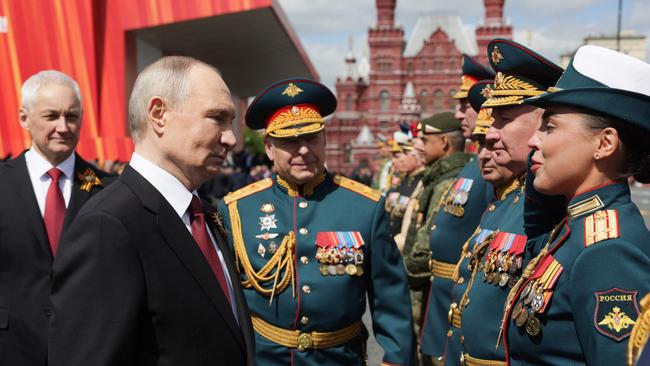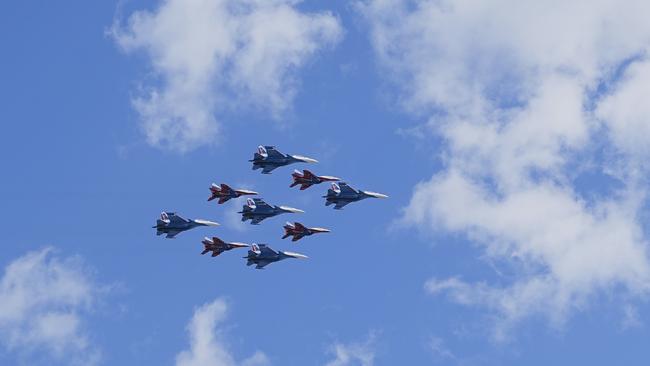Putin parades China, North Korea ties in Victory Day show of force
Vladimir Putin hosted the largest gathering of foreign leaders since the start of Russia’s invasion of Ukraine, including Chinese leader Xi Jinping, as the Russian president put on a display of military might to celebrate the Soviet Union’s defeat of the Nazis in World War II.

Vladimir Putin hosted the largest gathering of foreign leaders since the start of Russia’s invasion of Ukraine, including Chinese leader Xi Jinping, as the Russian president put on a display of military might to celebrate the Soviet Union’s defeat of the Nazis in World War II.
Putin drew parallels between Moscow’s war in Ukraine and World War II, as he delivered a speech to assembled world leaders in Red Square, covered in celebratory red banners. He has cast the invasion of Ukraine as a “special military operation” to root out Nazis there — a narrative that has been widely rejected internationally as a false justification for an imperialistic war.
“Truth and justice are on our side,” he said. “The entire country, the society, the people, support the participants in the special military operation.”
Putin also acknowledged the contributions of allied countries in World War II, but put them in the shadow of the battles the Soviet Union won against invading Nazi troops.
Moscow’s current backers took centre stage on Friday. The celebrations included a parade, with Chinese troops marching alongside Russian soldiers and Iran’s Shahed drones on display, along with Russian tanks and missiles. Putin shook hands with five North Korean officers at the parade, including three generals that South Korea’s spy agency said were leading the thousands of troops fighting alongside Russians.

The celebrations took place in the shadow of growing violence between Russia and Ukraine. Kyiv has sent waves of drones into Russia in recent days, disrupting the arrival of some international leaders to Moscow.
Meanwhile, Ukrainian officials said Russia wasn’t adhering to a ceasefire that Putin had called for from May 8-10, with its forces firing on civilian targets Friday. Ukrainian President Volodymyr Zelensky called the purported ceasefire a “theatrical performance.”
The events in Red Square were an attempt at a diplomatic show of force for Putin, who has worked to defy Western efforts to isolate him. His guest list included leaders from Venezuela, Cuba and Vietnam, as well as a host of former Soviet states.
The Trump administration, which has raised the prospect of a rapprochement with Moscow as part of a peace agreement, has recently signalled frustration with Russian intransigence in the conflict. The Kremlin wants to underscore for Washington that it is still a powerful player on the world stage that could be a dangerous enemy or a potentially useful partner with ties to many countries.
“Putin wants to show that Russia is an important and well-connected player in the world and that co-operating with Moscow could help Trump,” said Vasily Kashin, director of the Center for Comprehensive European and International Studies at the Moscow-based Higher School of Economics. “On the other hand, having Russia as an enemy is dangerous.”

Xi’s presence in Red Square as part of a four-day trip to Moscow was a huge show of support for Russia, whose great-power status has increasingly slipped in recent years as the Kremlin’s attention has narrowed to its war in Ukraine. China has provided economic and diplomatic support to Russia and has remained a crucial conduit for dual-use goods deployed on the front lines.
Attendance at the parade has become a divisive issue in the European Union. Slovak Prime Minister Robert Fico made it to Moscow after blaming Estonia for denying his plane permission to transit to reach the parade.
This year marks the 80th anniversary of the allied victory over Nazi Germany, and celebrations were staged across Russia’s 11 time zones and in occupied Ukraine. In the days and weeks leading up to the holiday, authorities have launched festivities with World War II trivia competitions for schoolchildren, Victory Day themed events at private shooting ranges and plays and musicals put on by theatres in Moscow and beyond.
“What we’re still seeing is a Russian fixation on pageantry, and there are people on the hook to deliver a big party, and that’s what they’re going to,” said Andrew Weiss, vice president for studies at the Carnegie Endowment for International Peace, where he oversees research on Russia and Eurasia.

In the towns and cities of Ukraine’s occupied Donetsk and Zaporizhzhia provinces, Russian soldiers put on celebrations, singing World War II songs and distributing flowers to residents. In Krasnodar, in southern Russia near the border with Ukraine, children dressed up in World War II era uniforms took part in a military-themed parade, while parents and onlookers looked on filming and clapping.
World War II, or the Great Patriotic War as it is known in Russia, remains a powerful event in the country’s collective memory. Many families can recite the names of forebears who died in the conflict, either on the front line or as a result of the Nazi invasion. The Soviet Union lost 27 million people in the war and Russian historians count nearly 9 million military casualties.
While Russia takes credit for defeating the Nazis, some historians blame the Kremlin under Stalin for contributing to the outbreak of World War II by signing a non-aggression pact with Hitler in 1939.
The holiday, which had stopped and started at different times during the Soviet Union, has become a defining feature of Putin’s reign. The Russian leader has sought to celebrate the Kremlin’s own version of history, and justify the costly war in Ukraine and ramped-up military spending.
“It is so awfully disconnected from the Second World War,” said Sergey Radchenko, a Cold War scholar and professor at the Johns Hopkins School of Advanced International Studies. “It’s about today’s regime, Putin’s various conquests and the Kremlin’s legitimacy.”
The parade on May 9 has always been a show of the Kremlin’s military might, but this year Russia’s soaring arms production allowed Putin to showcase more weapons on the streets of Moscow than at any other time during the Ukraine war. Those included tanks and Russia’s hypersonic missiles. Russian drones, which are playing a huge role on the battlefield, were paraded through Red Square together with their operators.
“Their production is way up,” said Rob Lee, a Russian military analyst and senior fellow at the Foreign Policy Research Institute, a foreign-policy think tank. “They want to show it off.”
Wall Street Journal




To join the conversation, please log in. Don't have an account? Register
Join the conversation, you are commenting as Logout